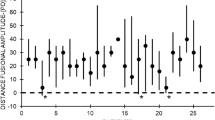Abstract
Purpose
Potential factors influencing stereopsis were investigated in patients with both refractive accommodative esotropia (RAE) and amblyopia.
Materials and methods
A retrospective chart review was performed to find out all patients with the diagnosis of both RAE and amblyopia. Patients are classified into two groups: group 1 (with stereopsis) and group 2 (without stereopsis). Onset age of RAE, history of strabismus in family members, time of amblyopia treatment, mean spherical equivalent, anisometropia, ocular movement disorders, especially, overaction of inferior oblique (IO) muscle, visual acuity difference (VAD) between eyes, best-corrected visual acuity (BCVA) levels of amblyopic and normal eyes and the presence of alternation of fixation (AOF) were investigated as possible factors. These factors were compared statistically between groups.
Results
Groups 1 and 2 consisted of 21 and 26 patients, respectively. There was no statistical significant difference in terms of onset age of RAE, family history, amblyopia treatment, BCVA of normal eyes and anisometropia. IO overaction and higher VAD were found to be statistically different between groups (p: 0.019, p: 0.022, respectively). Besides, there was significant difference in terms of AOF and better BCVA in amblyopic eyes (p: 0.000, p: 0.009, respectively).
Conclusion
IO overaction, BCVA in amblyopic eyes, VAD and AOF were found to be potential risk factors for the development of stereopsis in patients with both RAE and amblyopia.
Similar content being viewed by others
References
Rutstein RP (2008) Update on accommodative esotropia. Optometry 79:422–431
Birch EE (2003) Binocular sensory function in accommodative esotropia. J AAPOS 7:369–373
Birch EE, Wang J (2009) Stereoacuity outcomes following treatment of infantile AND accommodative esotropia. Optom Vis Sci 86(6):647–652
Berk T, Koçak N, Ellidokuz H (2004) Treatment outcomes in refractive accommodative esotropia. J AAPOS 4:384–388
Güçlü H, Gürlü VP, Özal SA, Özkurt ZG (2015) Prognostic factors for stereopsis in refractive accommodative esotropia. Pak J Med Sci 31(4):807–811
Uretmen O, Köse S, Öztaş S, Eğrilmez S (2007) Factors influencing stereoacuity in refractive accommodative esotropia. Can J Ophthalmol 42(4):600–604
Weakley DR Jr, Birch E, Kip K (2001) The role of anisometropia in the development of accommodative esotropia. J AAPOS 5:153–157
Matsuo T, Yamane T, Fujiwara H, Ohtsuki H, Watanabe Y (2005) Predictive factors for long term outcome of stereoacuity in Japanese patients with pure accommodative esotropia. Strabismus 13:79–84
Fawcett SL, Birch EE (2003) Risk factors for abnormal binocular vision after successful alignment of accommodative esotropia. J AAPOS 7:256–262
Ciuffreda KJ, Levi DM, Selenow A (1991) Amblyopia: basic and clinical aspects. Butterworth-Heinemann, Stoneham
Dennis ML, David CK, Daphne B (2015) Stereopsis and amblyopia: a mini-review. Vis Res 114:17–30
Hakim OM (2007) Association between fixation preference testing and strabismic pseudoamblyopia. J Pediatr Ophthalmol Strabismus 44(3):174–177
Erkan Turan K, Taylan Sekeroglu H, Karahan S, Sanac AS (2017) Fixation preference test: reliability for the detection of amblyopia in patients with strabismus and interexaminer agreement. Int Ophthalmol 37:1305–1310
Birch EE, Petrig B (1996) FPL and VEP measures of fusion, stereopsis and stereoacuity in normal infants. Vis Res 36:1321–1327
Birch EE, Fawcett S, Morale S, Jeffrey B, O’Connor A (2002) Measurement of stereoacuity outcomes during infancy: infant random dot stereocards. Invest Ophthalmol Vis Sci 43:A2937
Fawcett S, Leffler J, Birch EE (2000) Factors influencing stereacuity outcomes in accommodative esotropia. J AAPOS 4:15–20
Lee HJ, Kim S-J, Yu YS (2017) Stereopsis in patients with refractive accommodative esotropia. J AAPOS. https://doi.org/10.1016/j.jaapos.2017.05.009
Weakley DR Jr, Urso RG, Dias CL (1992) Asymmetric inferior oblique overaction and its association with amblyopia in esotropia. Ophthalmology 99(4):590–593
Acknowledgements
The statistical analysis was made by Saliha Yılmaz. Thanks for her work.
Author information
Authors and Affiliations
Corresponding author
Ethics declarations
Conflict of interest
The authors declare that they have no competing interests.
Human and animal rights
Human participants in this study were in accordance with the ethical standards of institutional research committee. Written informed consent was obtained from the parents of each subject in this study. The study was performed in adherence to the 1964 Declaration of Helsinki.
Rights and permissions
About this article
Cite this article
Çakır, B., Bursalı, Ö., Özmen, S. et al. Factors influencing stereopsis in patients with both refractive accommodative esotropia and amblyopia. Int Ophthalmol 39, 1263–1267 (2019). https://doi.org/10.1007/s10792-018-0937-8
Received:
Accepted:
Published:
Issue Date:
DOI: https://doi.org/10.1007/s10792-018-0937-8




